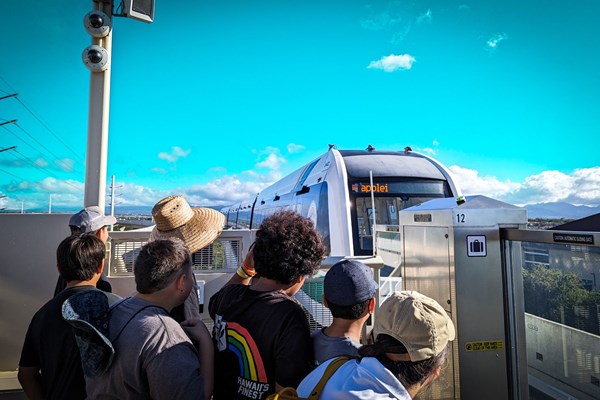Skyline transforms the way people travel
Aug 28, 2024

Over the past year, Honolulu Skyline has transformed the way many people travel by becoming an additional resource to get out and about. There were nearly 90,000 riders last month and an average of 3,076 riders each day for the first quarter of 2024.
Featured in our Multimodal Movement segments on KITV this month, the sustainable and resilient, Skyline is powered by electricity and is aimed to further reduce dependence on cars. It’s also reliable, convenient and easy to use. The trains run every 10 minutes in both directions from nine rail stations. This makes exploring a neighborhood, doing errands, or getting to work easy. Environmentally friendly, it also saves people money.
“I love the convenience. I don’t need to sit in rush hour traffic,” said Kapolei resident Hana Manuel in one of this month’s Multimodal Movement segments. “It actually is much cheaper than putting gas in my car, so I get to save a little bit of money. The HOLO card is really simple. It’s an easy tap and you’re in, so it’s very convenient. I would say try it out. If it can work for you and you can make it work for your lifestyle, then why not?”
The segment also offers helpful tips for using Skyline:
- Have your HOLO card loaded and ready.
- Transfer between buses and Skyline, all with one HOLO card!
- Visit Honolulu.gov/Skyline for more information.
These Multimodal Movement segments share information and highlight the benefits of riding the bus, biking, walking and rail, among others. They also encourage folks to think about changing the way they travel. Viewers see how everyday multimodal transportation users go about their day without having to depend on driving a car, how making the choice is easy, and how it helps to reduce carbon emissions and traffic. The goal is to increase awareness of multimodal transportation choices and encourage residents to change their routines and mindset about getting around.
Another significant benefit of not owning a car is saving money on gas and maintenance. In Hawai‘i, personal vehicles cost an average of $16,200 per household per year, and the cost of vehicle ownership continues to increase. Factoring in all public costs (state and county expenditures, social and economic trade-offs, and real estate value of land set aside for roadways and parking), the total comes to an estimated $40,600 per household per year.
Watch the two Multimodal Movement spots featuring Skyline: Part 1 and Part 2.

